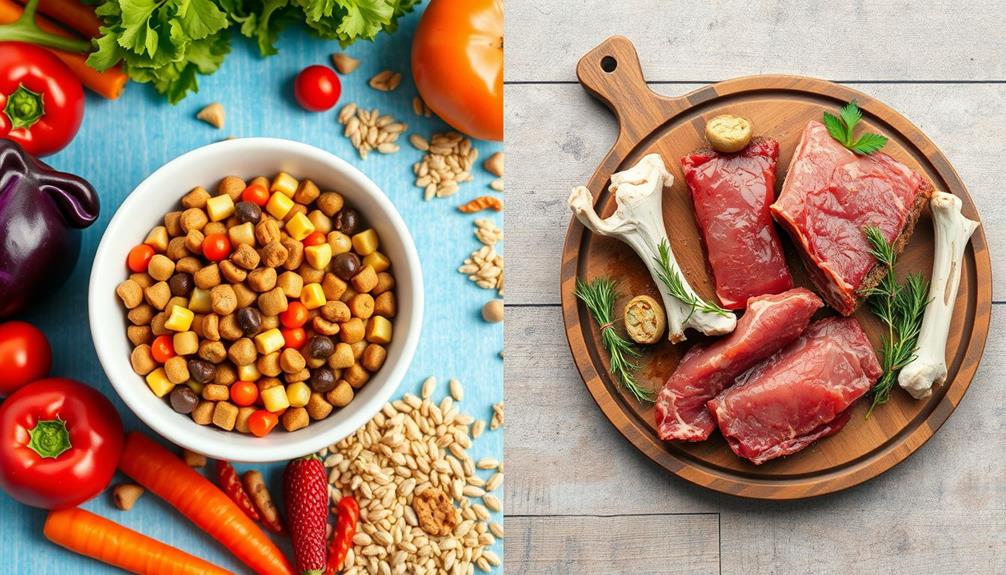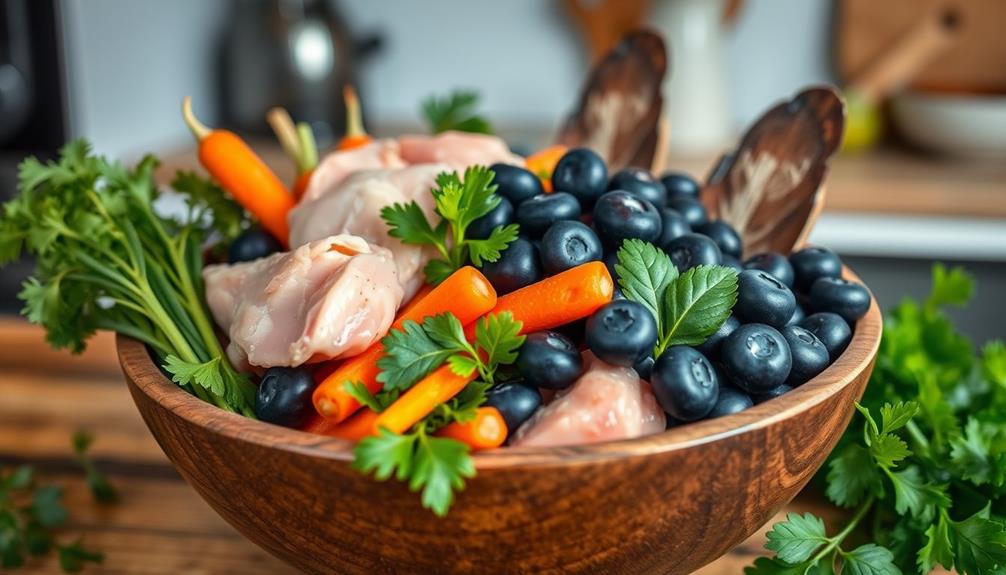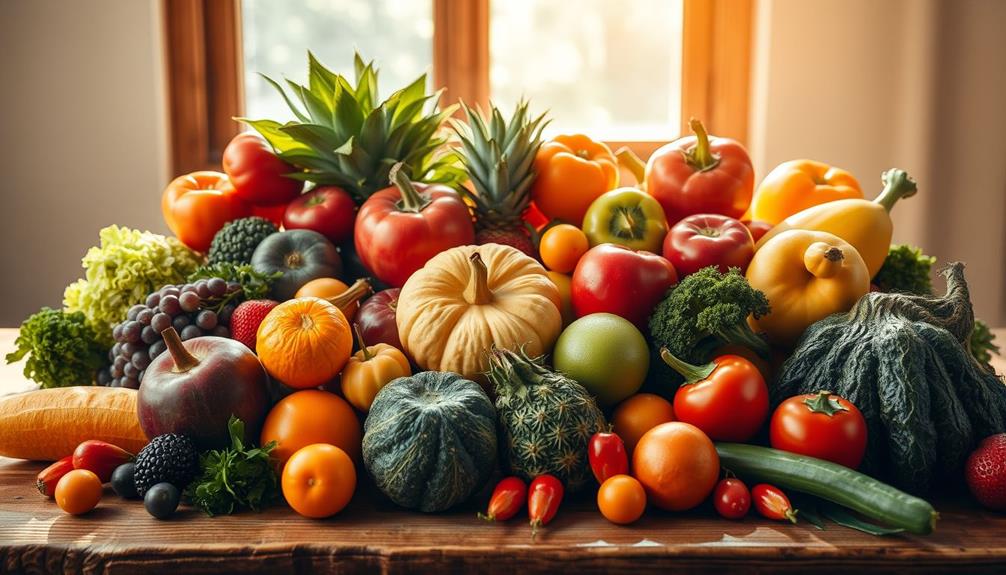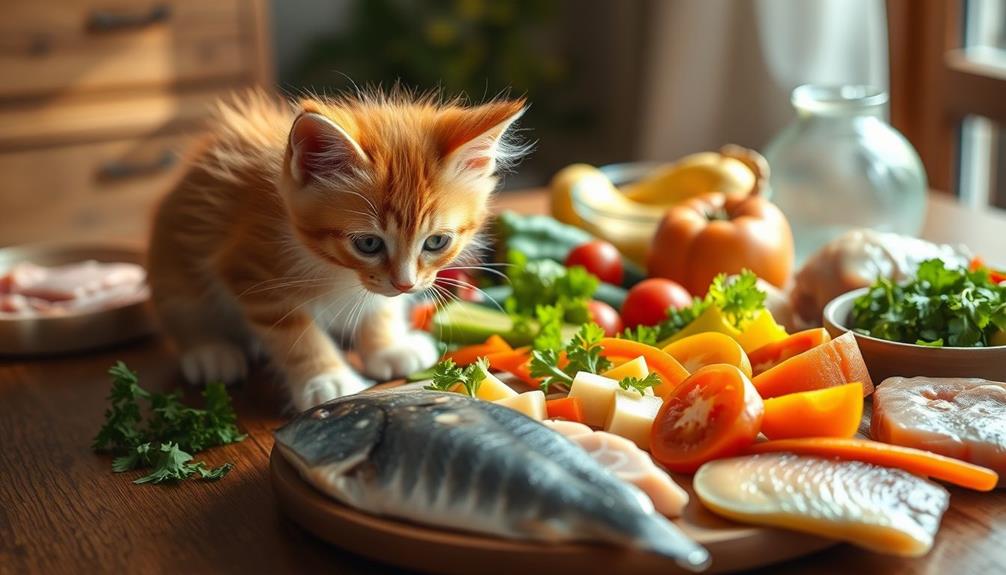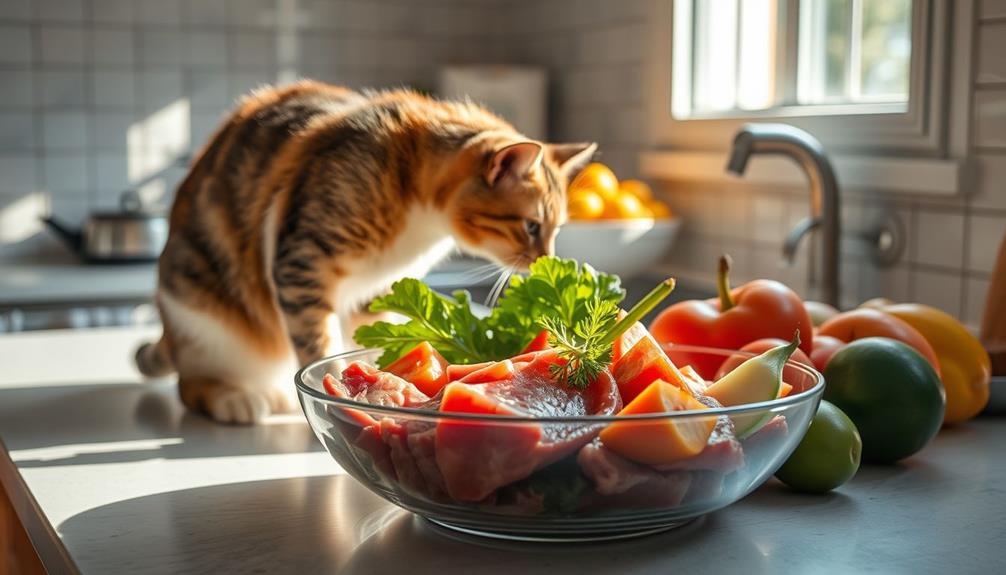Making your own raw cat food is easy and rewarding. Start with high-quality meats like chicken and include organ meats for essential nutrients. You'll need to add bones for dental health and some egg yolks for moisture. Always keep hygiene in mind; wash your hands and sanitize surfaces after handling raw ingredients. Gradually introduce raw food to your cat's diet by mixing it with their current food. Store any leftovers in airtight containers, and check for spoilage. Following these steps helps guarantee your cat stays healthy and happy. There's plenty more to discover about raw diets, so keep exploring!
Key Takeaways
- Start by gradually introducing raw food, mixing 10-20% with the current diet for a smooth transition over 7-10 days.
- Use high-quality meats, organs, and bones as the foundation of the raw diet, ensuring nutritional balance with supplements like taurine and vitamins.
- Maintain hygiene by washing hands, disinfecting surfaces, and using separate cutting boards to prevent cross-contamination during food preparation.
- Store raw cat food in airtight containers, refrigerating for 48-72 hours or freezing portions for longer storage, ensuring complete thawing before serving.
- Monitor your cat's health and digestive response, consulting a veterinary nutritionist to address any dietary concerns and ensure balanced nutrition.
Understanding Raw Cat Food
Understanding raw cat food is vital if you want to provide your feline friend with a diet that closely resembles what they'd naturally eat in the wild. As obligate carnivores, cats thrive on a prey-based diet rich in high-quality meat, organs, and bones.
This homemade diet needs to include essential nutrients like taurine and arginine, along with balanced calcium and phosphorus ratios, to support your cat's overall health. It's important to guarantee that any raw food prepared is safe, similar to the care recommended for other pets like hamsters, where proper handling can prevent health issues safe animal care practices.
When shifting to raw cat food, start slowly by mixing small amounts into their current food. This gradual approach helps avoid digestive upset as your cat adapts.
However, proper handling and hygiene are important when preparing raw meals. Taking these precautions minimizes health risks, such as bacterial contamination from salmonella or E. coli, which can affect both you and your pet.
Be vigilant about monitoring your cat's health and adjust their diet as needed. Homemade raw diets can lead to nutrient imbalances if not formulated correctly, so it's wise to consult with a veterinarian or a pet nutritionist.
Essential Ingredients for Raw Diet
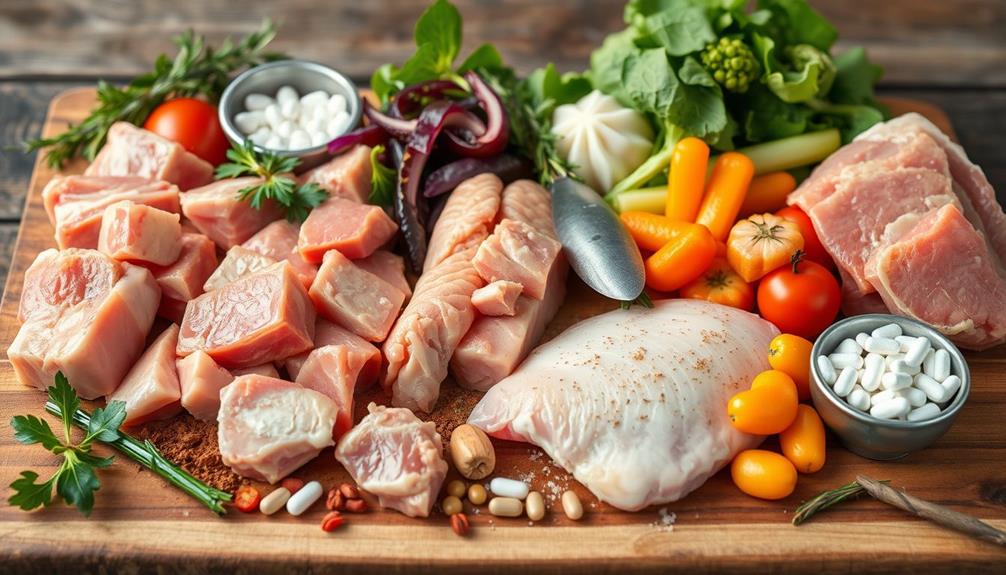
Creating a balanced raw diet for your cat requires a careful selection of essential ingredients. Start with high-quality meats, like chicken thighs, as they form the foundation of your cat's meals. Incorporate organs such as hearts and livers to provide vital nutrients that whole meats alone can't offer.
Additionally, it's important to take into account the nutritional needs of your cat, similar to how one must be aware of cold medications overview when managing health. Don't forget to include bones; they promote dental health and add necessary minerals.
To guarantee your cat's diet mimics their natural prey, add egg yolks and water for moisture content. This keeps your feline hydrated and happy. It's important to supplement your homemade meals with taurine, vitamin E, and vitamin B-complex. These nutrients are essential since whole foods often lack them.
When preparing your raw meals, sprinkle in some lite salt with iodine to support thyroid function and overall health, especially if your recipes don't include certain seafood or organ meats.
Nutritional Balance and Supplements
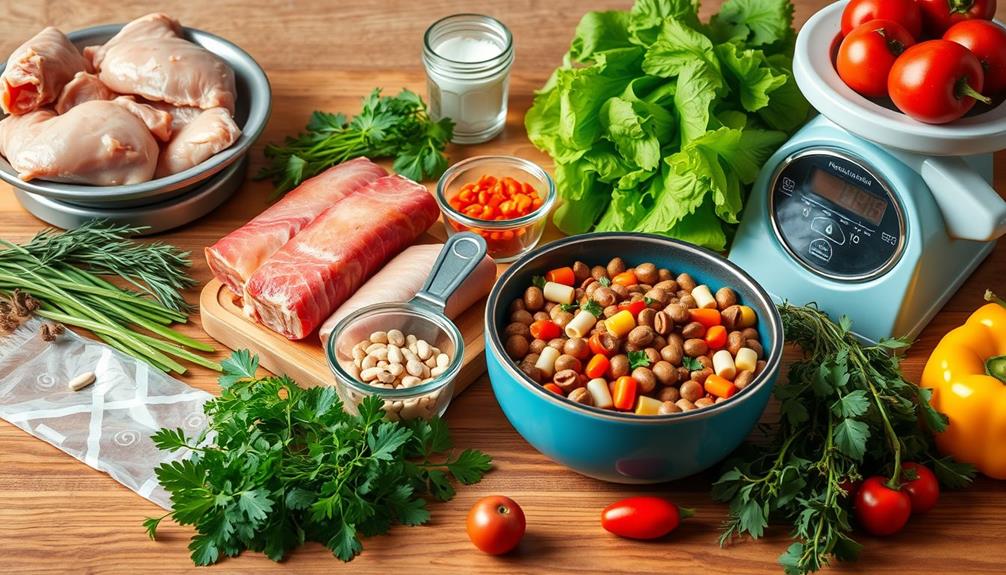
Maintaining nutritional balance in your cat's raw food diet is fundamental for their overall health. To guarantee your feline friend receives complete nutrition, it's essential to include essential nutrients like taurine, arginine, calcium, and phosphorus.
Caregivers should also be aware of the financial considerations for elderly care that can affect their ability to provide for pets alongside senior family members. Here are three key components to take into account:
- Consult a Veterinary Nutritionist: A board-certified veterinary nutritionist can help you formulate balanced recipes, avoiding common nutrient imbalances in homemade diets.
- Incorporate Supplements: Whole foods often lack critical components. Ponder adding supplements such as vitamin E, B-complex, wild salmon oil, and lite salt with iodine to fill these gaps and support your cat's health.
- Regular Health Monitoring: Conduct regular health checks and blood tests. This practice guarantees your cat's diet continues to meet their evolving nutritional needs, especially as they age or face health changes.
Preparing Raw Cat Food Safely

When you're preparing raw cat food, hygiene and safety are essential.
Always wash your hands and sanitize surfaces to avoid bacterial contamination.
Additionally, it's important to keep the preparation area free from allergens and pollutants, much like maintaining clean air in your home with an air purifier, which can enhance your pet's overall well-being by providing a healthier environment air purifier maintenance dos and don'ts.
Proper food storage and safe ingredient handling will help keep your cat healthy and happy.
Hygiene and Safety Practices
Proper hygiene and safety practices are essential for anyone preparing raw cat food. To guarantee your cat's meals are safe and free from harmful bacteria, follow these steps:
1. Wash Your Hands: Always wash your hands thoroughly with soap and water before and after handling raw meat. This simple act prevents the spread of bacteria like salmonella and E. coli.
Additionally, just as the presence of security systems can deter potential threats, maintaining strict hygiene can considerably reduce the risk of foodborne illnesses.
2. Disinfect Preparation Surfaces: After preparing raw food, disinfect all surfaces, utensils, and storage containers using a bleach solution or appropriate disinfectants. This eliminates potential pathogens and keeps your kitchen safe.
3. Avoid Cross-Contamination: Use separate cutting boards for raw meat and other food items. Clean any surface that comes into contact with raw meat immediately to prevent cross-contamination.
In addition to these practices, be mindful of food storage. Store raw cat food in airtight containers and use it within 48-72 hours.
If you have leftovers, freeze them to maintain freshness. Remember, safety practices not only protect your health but also guarantee your cat enjoys nutritious, safe meals.
Proper Food Storage
Storing raw cat food safely is vital for your cat's health and well-being. To guarantee proper food storage, always keep prepared raw cat food in airtight containers and refrigerate it for no more than 48-72 hours. This helps maintain freshness and prevent spoilage.
If you need to store food for a longer period, freeze portions of raw cat food, but remember to thaw each portion completely before serving to avoid bacterial growth. It's important to understand how to manage your budget for pet expenses, as budgeting for pet care can help you allocate funds for high-quality ingredients.
Regularly check for signs of spoilage, such as off odors or discoloration, before feeding your cat. This step is essential for food safety.
After food preparation, clean and sanitize all areas, tools, and feeding dishes to minimize the risk of bacterial contamination, like salmonella.
It's also important to use separate containers for raw food and other types of food. This practice helps prevent cross-contamination and maintains strict hygiene protocols during food storage.
Safe Ingredient Handling
Handling ingredients safely is just as important as storing raw cat food correctly. To guarantee your cat's meals are free from harmful bacteria, follow these essential safe ingredient handling tips:
- Wash Your Hands: Always wash your hands thoroughly with soap and water before and after handling raw meat. This helps prevent cross-contamination and the spread of foodborne pathogens like salmonella. Using essential oils for cleaning can also enhance your kitchen's hygiene.
- Use Separate Equipment: Designate a cutting board specifically for raw meat. This minimizes the risk of contamination with other food items. Consider using color-coded boards for clarity and safety.
- Clean and Disinfect: After preparing raw cat food, clean and disinfect all surfaces, utensils, and equipment used. This step is vital in reducing the chance of lingering bacteria.
Additionally, when you store raw cat food, keep it in airtight containers in the refrigerator for no more than 48-72 hours.
If you're using bones, monitor their size carefully to avoid choking hazards. Grinding bones or using calcium supplements can help guarantee safety and nutritional balance.
Following these steps will help you prepare safe, healthy meals for your feline friend.
Step-by-Step Recipe Instructions
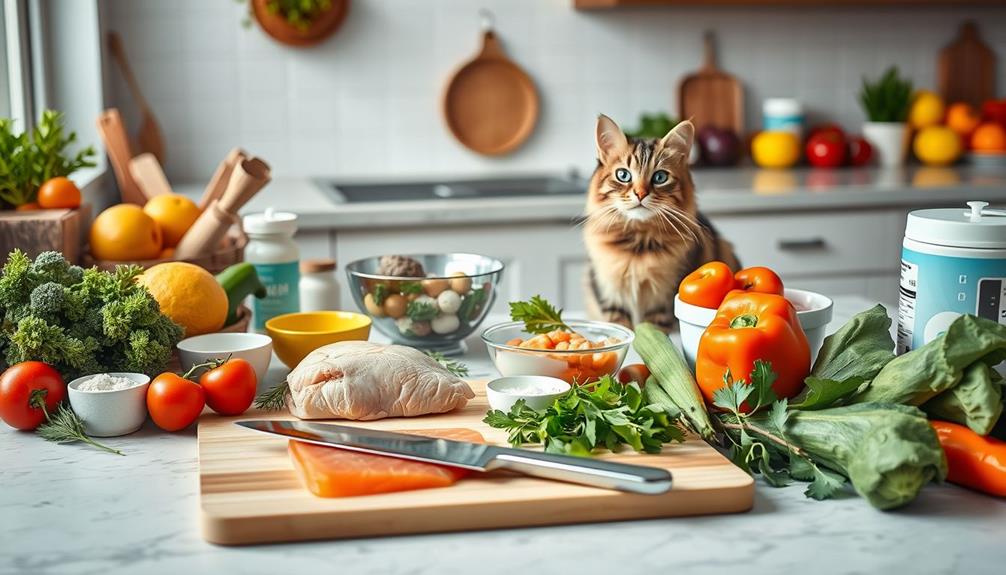
Making raw food for your cat is a rewarding process that guarantees they receive a balanced diet tailored to their needs. Start by gathering high-quality ingredients: lean meat, bones, and organs. Blend these using a high-power blender or food processor until well-combined. Next, create a supplement slurry using water, egg yolks, and essential vitamins to fortify the mixture and guarantee nutritional balance. Lastly, portion the raw food mixture into containers and freeze them for later use. When it’s time to feed your cat, simply thaw a portion in the refrigerator and serve. The raw food benefits for cats include improved digestion, healthier coat and skin, and overall better energy and vitality. With a little bit of preparation, you can ensure your cat is getting the best possible nutrition with homemade raw food.
| Ingredient | Purpose |
|---|---|
| Meat and Organs | Main protein source |
| Supplement Slurry | Nutritional enhancement |
| Airtight Containers | Storage and portion control |
Portion the prepared raw food into airtight containers, which makes meal prep convenient and allows for storage up to four months. When serving, warm the food slightly to mimic body temperature. It's vital to monitor your cat's reaction to the new diet and adjust as needed. This step helps you guarantee they're adapting well and receiving the right nutrients without digestive upset. By following these instructions, you'll provide your feline friend with a healthy, satisfying diet they'll love!
Transitioning Your Cat to Raw Food

When changing your cat to raw food, start by mixing small amounts with their current diet and gradually increasing it over 7-10 days.
This slow introduction helps minimize any digestive issues, so keep a close eye on how your cat responds.
It's also important to make sure that the raw food is nutritionally balanced, as deficiencies can arise from an unmonitored diet, similar to how juice diets may lead to nutrient deficiencies if not properly balanced.
If you notice any signs of distress, you may need to adjust the mix or slow down the process.
Gradual Introduction Process
Shifting your cat to a raw food diet requires patience and careful planning to guarantee a smooth adjustment. The key is a gradual introduction, allowing your feline friend to adapt without digestive upset. Following the principles of key domains of development in psychology can also be beneficial, as they emphasize the importance of gradual changes and monitoring progress.
Follow these steps for a successful change:
- Start Small: Begin by mixing a small amount of raw food with your cat's current diet. Aim for about 10-20% raw food initially.
- Increase Gradually: Over the next 7-10 days, gradually increase the proportion of raw food while decreasing the commercial diet. This helps your cat acclimate.
- Monitor Closely: Keep an eye on your cat's response. Look for any signs of digestive issues, like diarrhea or vomiting, and adjust the amount accordingly.
Consulting with a veterinary nutritionist can make certain the new raw diet includes balanced recipes that meet all nutritional requirements.
Also, offering a variety of proteins can help your cat explore different flavors and textures, making the change smoother.
Monitor Digestive Health
Monitoring your cat's digestive health during the change to a raw food diet is vital for guaranteeing a smooth adjustment. Start by gradually introducing raw food, mixing small amounts with their current diet over 7-10 days. This approach minimizes digestive upset and allows their system to adjust properly.
During this change, consider incorporating healthy dog snacks that may inspire a positive eating experience for your cat.
As you adapt, closely monitor your cat's stool consistency and frequency. Firmer stools often indicate a successful adjustment, while diarrhea may mean you need to slow the introduction.
Also, keep an eye on your cat's overall behavior and energy levels; increased playfulness or curiosity can signal they're adapting well to the new diet.
It's important to remember that some cats might initially refuse raw food. Stay patient and persistent, and try offering different protein sources until you find one they enjoy.
Throughout the adjustment process, consulting with a veterinarian is vital. They can help you maintain a proper nutrient balance and address any concerns about your cat's digestive health.
Common Mistakes to Avoid
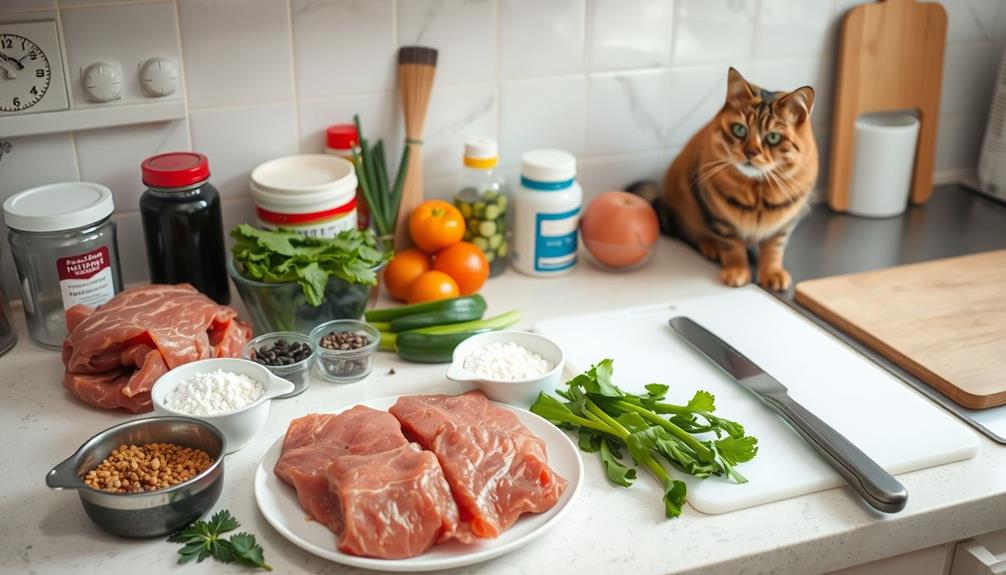
Creating a homemade raw food diet for your cat can be rewarding, but there are common pitfalls that can jeopardize your efforts. To make certain your cat thrives on this diet, avoid these mistakes:
- Neglecting Professional Guidance: Failing to consult a board-certified veterinary nutritionist can lead to nutrient imbalances. Many homemade cat food recipes lack essential nutrients, which could threaten your cat's health.
- Skipping Essential Supplements: Don't overlook necessary supplements like taurine, vitamin E, and B-complex vitamins. These nutrients are crucial for your cat's overall well-being, and missing them can lead to severe health issues.
- Poor Food Handling Practices: Improper food handling and hygiene can increase the risk of raw meat contamination. Always make certain your preparation areas and tools are thoroughly cleaned to prevent bacterial infections, such as salmonella.
Additionally, remember to gradually shift your cat to a raw food diet. Start with small amounts mixed into their current food and slowly increase the homemade portion to avoid digestive upset.
Storage and Meal Prep Tips
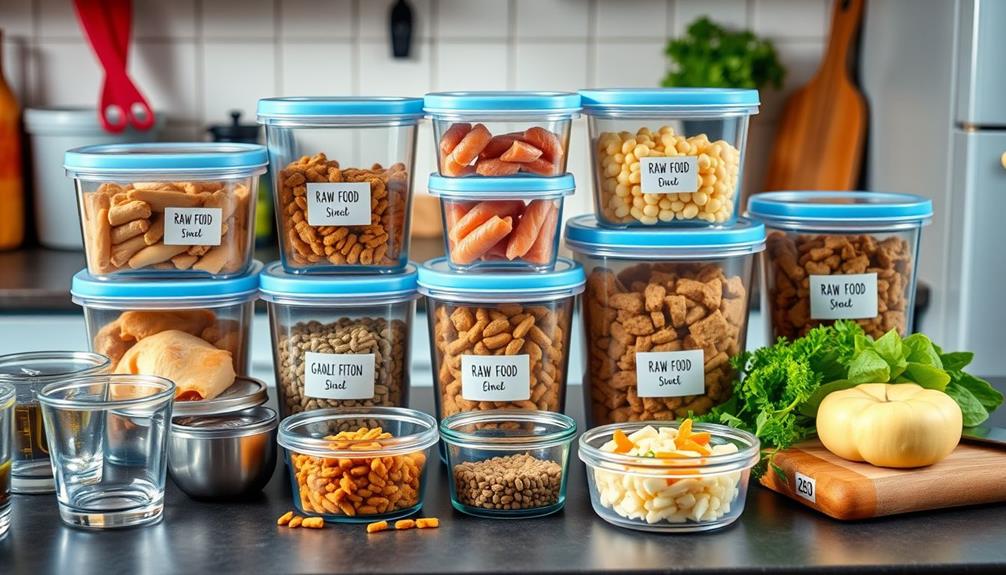
When it comes to storing your cat's raw food, keeping it fresh is key.
You'll want to use airtight containers and portion out meals for easy access, ensuring each serving meets your cat's dietary needs.
Don't forget to follow proper thawing techniques to maintain quality and safety before serving.
Food Storage Guidelines
Proper food storage is vital for keeping your cat's raw meals safe and fresh. Following these food storage guidelines will help guarantee your cat enjoys healthy and tasty meals.
- Use airtight containers: Store prepared raw cat food in airtight containers to maintain freshness. Refrigeration is limited to 48-72 hours before consumption, so keep track of how long the food's been in the fridge.
- Freeze portions: For longer storage, freeze portions of raw food. Make sure to consume them within four months for best quality and safety.
- Thaw properly: Always thaw frozen raw food completely in the refrigerator before serving. Never thaw at room temperature to prevent bacterial growth.
Additionally, regularly inspect stored food for any signs of spoilage, such as off odors or discoloration, before feeding it to your cat.
It's also important to use separate containers for different batches or recipes to avoid cross-contamination, which can affect your cat's health.
Portion Control Strategies
Maintaining the right portion size for your cat's raw food is essential for their health and well-being. Effective portion control strategies can make feeding your cat easier while ensuring they get the right daily feeding amounts. Here's how to manage your homemade raw cat food:
- Portioning: Divide prepared food into containers that match your cat's ideal daily feeding amount, typically 2-4% of their body weight.
- Storage: Keep prepared food in the refrigerator for up to 48-72 hours, and freeze larger batches for up to four months to monitor freshness and prevent spoilage.
- Labeling: Clearly label containers with the preparation date and portion size to help you track freshness and avoid overfeeding.
- Spoilage Check: Regularly inspect food for signs of spoilage, such as off odors or discoloration.
Here's a table to help you manage your cat's feeding:
| Container Size | Daily Amount (lbs) | Storage Duration |
|---|---|---|
| 1 cup | 0.5 – 1.0 | 48-72 hours |
| 2 cups | 1.0 – 2.0 | 48-72 hours |
| 3 cups | 2.0 – 3.0 | 48-72 hours |
| 4 cups | 3.0 – 4.0 | 48-72 hours |
| 5 cups | 4.0+ | 48-72 hours |
Thawing and Serving Tips
Thawing raw cat food correctly is fundamental for keeping it safe and palatable for your feline friend. Always thaw your cat's food in the refrigerator to prevent bacterial growth, guaranteeing food safety.
It's important to serve the thawed food at a temperature close to mouse body temperature for ideal palatability, which you can achieve by warming it slightly in the microwave.
Here are some tips for thawing and serving raw cat food:
- Use Airtight Containers: Store prepared raw cat food in airtight containers to prevent spoilage and maintain freshness. Consume refrigerated food within 48-72 hours.
- Portion for Freezing: When freezing food, portion it into small containers. This method facilitates quicker thawing and minimizes waste. Aim for a maximum storage duration of four months.
- Check for Spoilage: Before serving, regularly check thawed food for signs of spoilage, such as off odors or discoloration. This is essential to guarantee your cat's safety.
Benefits of Raw Food Diet

A raw food diet offers numerous benefits for your cat, aligning perfectly with their natural obligate carnivore instincts. By focusing on a raw diet rich in animal protein and low in carbohydrates, you can help prevent obesity and diabetes, two common health issues in cats today.
Homemade food allows you to take control of your cat's nutrition, ensuring they receive high-quality ingredients without harmful additives.
You'll likely notice improvements in your cat's overall health, coat quality, and energy levels after switching to this health food. Many pet owners report significant changes, showcasing how effective a raw diet can be.
Plus, the high moisture content in raw diets aids in hydration, which supports kidney health and reduces the risk of urinary tract problems often seen with dry food.
Another advantage is the ability to create tailored nutrition for your cat. If your feline has allergies or inflammatory bowel disease, you can easily modify their meals to address these specific conditions.
With a raw food diet, you're providing your cat with the best possible nutrition while enhancing their overall well-being.
Expert Advice and Resources

How can you guarantee your cat gets the right nutrients on a raw food diet? Seeking expert advice is fundamental. Consulting a board-certified veterinary nutritionist guarantees that your homemade cat food meets all nutritional needs, especially for essential nutrients like taurine and vitamin E.
Here are three key resources to contemplate:
- Feline Nutrition Foundation: This organization offers valuable guides and resources to help you shift your cat to a raw diet while addressing digestibility and nutrient adequacy concerns.
- Recipe Calculators: Use these tools to accurately measure ingredients. They help you maintain the right ratios of protein, fat, and essential nutrients tailored to your cat's dietary requirements.
- Regular Veterinary Check-Ups: Regular monitoring through veterinary visits and blood tests is crucial. This helps assess the effectiveness of the homemade diet and catch any potential nutrient deficiencies early.
Additionally, think about joining educational resources and community forums. These platforms provide support and shared experiences from other pet owners maneuvering the homemade cat food journey, fostering a collaborative environment for learning.
Frequently Asked Questions
How to Make Home Raw Cat Food?
To make home raw cat food, source high-quality meats and blend them with organ meats and necessary supplements. Portion the mix for easy access, and shift your cat gradually while monitoring their health.
How Do You Prepare Raw Meat for a Cat?
To prepare raw meat for your cat, start by sourcing fresh, high-quality meat. Grind it with bones and organs using a food processor, then mix in essential supplements for balanced nutrition before storing it properly.
Is It Cheaper to Make Your Own Raw Cat Food?
Imagine filling your cat's bowl with fresh, vibrant ingredients. You'll find that making your own raw cat food often costs less than premium brands, saving you money while ensuring your furry friend eats healthy and happy.
What Should I Add to My Cat's Raw Food?
You should add essential supplements like taurine, vitamin E, and B-complex to your cat's raw food. Incorporate high-quality fats like wild salmon oil and a mix of meat, organs, and bones for balanced nutrition.
Conclusion
Incorporating raw food into your cat's diet can be a game changer for their health and energy. By following these easy recipes and tips, you're not just feeding your feline; you're crafting a gourmet experience that could have them purring with delight. Remember, every meal is an opportunity to nourish their body and soul, so plunge in and enjoy the process. Your cat will thank you with every whisker twitch and playful leap!


